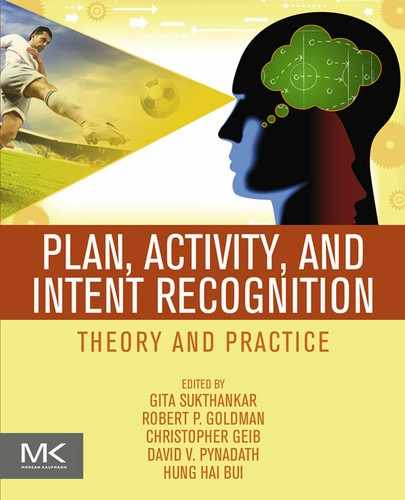Table of Contents
1: Hierarchical Goal Recognition
1.4 Metrics for Plan Recognition
1.5 Hierarchical Goal Recognition
2: Weighted Abduction for Discourse Processing Based on Integer Linear Programming
2.4 ILP-based Weighted Abduction
2.5 Weighted Abduction for Plan Recognition
2.6 Weighted Abduction for Discourse Processing
2.7 Evaluation on Recognizing Textual Entailment
3: Plan Recognition Using Statistical–Relational Models
3.3 Adapting Bayesian Logic Programs
4: Keyhole Adversarial Plan Recognition for Recognition of Suspicious and Anomalous Behavior
4.2 Background: Adversarial Plan Recognition
4.3 An Efficient Hybrid System for Adversarial Plan Recognition
4.4 Experiments to Detect Anomalous and Suspicious Behavior
4.5 Future Directions and Final Remarks
2: Activity Discovery and Recognition
5: Stream Sequence Mining for Human Activity Discovery
6: Learning Latent Activities from Social Signals with Hierarchical Dirichlet Processes
6.3 Bayesian Nonparametric Approach to Inferring Latent Activities
7: Modeling Human Plan Recognition Using Bayesian Theory of Mind
7.3 Comparing the Model to Human Judgments
8: Decision-Theoretic Planning in Multiagent Settings with Application to Behavioral Modeling
8.2 The Interactive POMDP Framework
8.3 Modeling Deep, Strategic Reasoning by Humans Using I-POMDPs
9: Multiagent Plan Recognition from Partially Observed Team Traces
9.3 Multiagent Plan Recognition with Plan Library
9.4 Multiagent Plan Recognition with Action Models
10: Role-Based Ad Hoc Teamwork
10.4 Importance of Role Recognition
10.5 Models for Choosing a Role
10.7 Conclusion and Future Work
11: Probabilistic Plan Recognition for Proactive Assistant Agents
11.2 Proactive Assistant Agent
11.3 Probabilistic Plan Recognition
11.4 Plan Recognition within a Proactive Assistant System
12: Recognizing Player Goals in Open-Ended Digital Games with Markov Logic Networks
12.5 Goal Recognition with Markov Logic Networks
12.8 Conclusion and Future Work
13: Using Opponent Modeling to Adapt Team Play in American Football
13.4 Play Recognition Using Support Vector Machines
13.6 Offline UCT for Learning Football Plays
13.7 Online UCT for Multiagent Action Selection
14: Intent Recognition for Human–Robot Interaction
14.2 Previous Work in Intent Recognition
14.3 Intent Recognition in Human–Robot Interaction
14.4 HMM-Based Intent Recognition
14.5 Contextual Modeling and Intent Recognition
